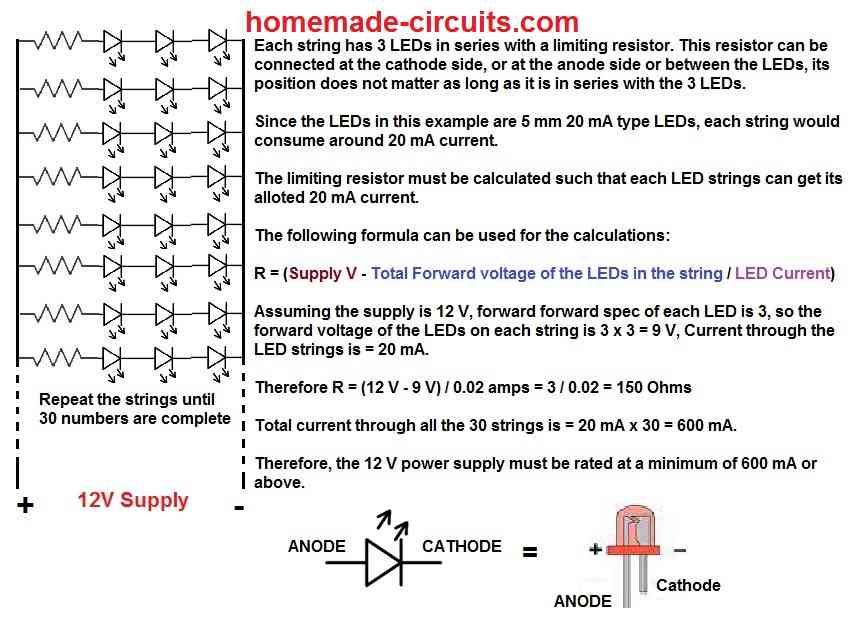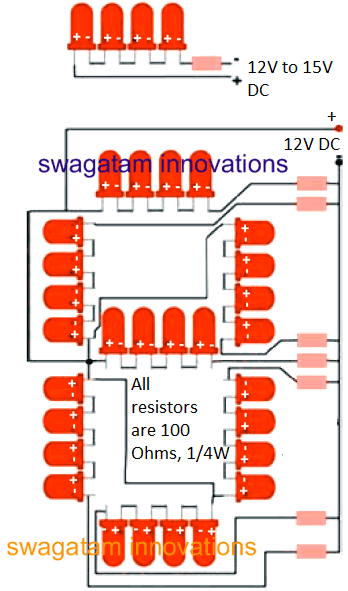In this article I have explained how to calculate LEDs in series and parallel using a simple formula and configure your own personalized LED displays, now you don't just have to wonder how to wire led lights? but actually can do it, know the details here.
These lights are known not only for their dazzling color effects, but also because of their durability and least power consumption.
Moreover LEDs can be wired in groups to form large alphanumeric displays which may be used as indicators or advertisements.
Young electronic hobbyists and enthusiasts are often confused and wonder how to calculate LED and its resistor in a circuit, since they find it difficult to optimize voltage and current through the group of LEDs, required to maintain an optimum brightness.
Why we need to Calculate LEDs
Designing LED displays may be fun, but very often we are just left thinking how to wire led lights? Learn through a formula how simple it is to design your own LED displays.
We already know that a LED requires a particular forward voltage (FV) to get lit. For example a red LED will need a FV of 1.2 V, a green Led will require 1.6 V and for a yellow LED it is around 2 V.
The modern LEDs are all specified with approximately 3.3V forward voltage irrespective of their colors.
But since the given supply voltage to an LED would be mostly higher than its forward voltage value, adding a current limier resistor with LED becomes imperative.
Therefore I have explained how a current limiter resistor may be calculated for a selected LED or a series of LEDs
Calculating Current Limiter Resistor
The value of this resistor may be calculated through the below given formula:
R = (supply voltage VS – LED forward voltage VF) / LED current I
Here R is the resistor in question in Ohms
Vs is the supply voltgae input to the LED
VF is the LED forward voltage which is actually the minimum supply voltage required by an LED for illuminating with optimal brightness.
When a series LED connection is in question, you will just need to replace the "LED forward voltage" with "total forward voltage" in the formula, by multiplying FV of each LED by the total number of LEDs in the series. Suppose there are 3 LEDs in series then this value becomes 3 x 3.3 = 9.9
LED Current or I refers to the current rating of the LED, it may anywhere from 20 mA to 350 mA depending on the specification of the selected LED. This must be converted to amps in the formula, so 20 mA becomes 0.02 A, 350 mA becomes 0.35 A and so on.
How to Connect the LEDs?
To understand this let's read the following discussion:
Let's assume you want to design a LED display having 90 LEDs in it, with a 12V supply to power this 90 LED display.
To optimally match and configure the 90 LED with the 12V supply, you will need to connect the LEDs in series and parallel appropriately.
For this calculation we will need 3 parameters to be considered which are as follows:
- Total number of LEDs which is 90 in our example
- Forward voltage of the LEDs, here we consider it to be 3V for sake of easy calculation, normally this would be 3.3V
- The supply input, which is 12V for the present example
First and formost we have to consider the series connection parameter, and check how many LEDs can be accomodated within the give supply voltage
We do this by dividing the supply voltage by 3 volts.
The answer will be obviously = 4. This gives us the number of LED that could be accommodated within the 12V supply.
However the above condition may not be advisable because that would confine the optimal brightness to a strict 12V supply and in case the supply reduced to some lower value would cause lower illumination on the LED.
Therefore to ensure a lower margin of at least 2V it would be advisable to remove one LED count from the calculation and make it 3.
So 3 LEDs in series for a 12V supply looks good enough and this would ensure that even if the supply was reduced to upto 10V, still the LEDs would be able to light up quite brightly.
Now we would want to know how many such 3 LED strings could be made from our total 90 LEDs in hand? Therefore, dividing the total number of LEDs (90) by 3, we get an answer that's equal to 30.

Meaning you would need to solder 30 numbers of LED series strings or chains, each string having 3 LEDs in the series. That's, pretty easy going right?
Once you finish assembling mentioned the 30nos of LED strings, you would naturally find that each string having its own positive and a negative free ends.
Next, connect the calculated value of resistors as discussed in the previous section to any one of the free ends of each series, you can connect the resistor at the positive end of the string or the negative end, the position doesn't matter because the resistor just needs to be in line with the series, you may even include some wher in between the LED series.Using the earler we find the resistor for each LED string to be:
R = (supply voltage VS – LED forward voltage VF) / LED current
= 12 - (3 x 3) / 0.02 = 150 ohms
Let's assume we connect this resistor to each of the negative ends of LED strings.
- After this, you can begin joining the common positive ends of the LEDs together, and the negative ends or the resistor ends of each series together.
- Finally apply 12 volts supply to these common ends as per the correct polarity. You will instantly find the whole design glowing up brightly with an uniform intensity.
- You may align and organize these LED strings as per the design of the display.
LEDs with an Odd Count
A situation may arise when your LED display contains LEDs in odd numbers.
For example, suppose in the above case instead of 90 if the display would have consisted 101 LEDs, then considering 12V as the supply, it becomes a rather awkward task to divide 101 with 3.
So we find the nearest value which is directly divisible with 3 which is 99. Dividing 99 with 3 gives us 33.
Therefore the calculation for these 33 LED strings would be as explained above but what about the remaining two LEDs? No worries, we can still make a string of these 2 LEDs and put it in parallel with the remaining 33 strings.
However to ensure that the 2 LED string consumed uniform current just like the remaining 3 LED strings, we calculate the series resistor accordingly.
In the formula we simply change the total forward voltage as show below:
R = (supply voltage VS – LED forward voltage VF) / LED current
= 12 - (2 x 3) / 0.02 = 300 ohms
This gives us the resistor value specifically for the 2 LED string.
Therefore we have 150 ohms for all the 3 LED strings, and 300 ohms for the 2 LED string.
In this manner you can adjust LED strings having mismatched numbers of LED by introducing a suitably compensating resistor in series with the respective LED strings.
Thus the problem is easily solved by changing the resistor value for the remaining smaller series.
This concludes our tutorial regarding how to connect LEDs in series and parallel for any given number of LEDs using a specified supply voltage, if you have any related query please use the comment box to get it solved.
Calculating LEDs in Series Parallel in Display Board
So far we leraned how LEDs may be connected or calculated in series and parallel.
In the following paragraphs we will investigate how to design a large numerical led display by joining LEDs in series and parallel.
As an example we will build a number display “8” using LEDs and see how it is wired.
Parts Required
You will need the following handful of electronic components for the construction:
RED LED 5mm. = 56 nos.
RESISTOR = 180 OHMS ¼ WATT CFR,
GENERAL PURPOSE BOARD = 6 BY 4 INCHES

How to Calculate and Construct LED Display?
The construction of this number display circuit is very simple and is done in the following way:
Insert all the LEDs in the general purpose board; follow the orientations as shown in the circuit diagram.
Initially solder only one lead of each LED.
After completing this, you will find that the LEDs are not aligned straight and are in fact fixed in quite a crooked manner.
Touch the soldering iron tip on the soldered LED point and simultaneously push the particular LED down so that its base is pushed flat on the board. Do this for all the LEDs to make them aligned straightly.
Now finish soldering the other unsoldered lead of each of the LEDs. Cut their leads cleanly with a nipper. According to the circuit diagram common up the positives of all the LED series.
Connect 180 Ohms resistors to the negative open ends of each series. Again, common up all the free ends of the resistors.
This ends the construction of the LED display number “8”. To test it, just connect a 12 volt supply to the common LED positive and the common resistor negative.
The number “8” should instantly light up in the form of a large numerical display and can be recognized even from long a distance.
Circuit Functioning Hints
To clearly understand how to design a large numerical led display it will be important to know the circuit functioning in details.
Looking at the circuit one may notice that the whole display has been divided into 7 LED series “bars”.
Each series contains a group of 4 LEDs. If we divide the input 12 volts with 4 we will find that each LED receives 3 volts enough to make them glow brightly.
The resistors make sure that the current to the LEDs is limited so that they may last long.
Now by just joining these series LEDs in parallel we can align them into different shapes to produce a huge variety of different alphanumeric displays.
Readers must have now easily understood how to calculate LED in different modes.
Its just a matter of connecting LEDs first in series, then joining these in parallel connections and applying a voltage to their common positives and negatives.